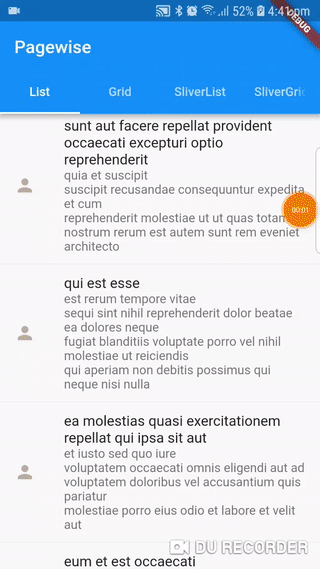A library for widgets that load their content one page (or batch) at a time (also known as lazy-loading and pagination).
- Load data one page at a time
- Retry failed pages
- Override the default loading, retry, and error widgets if desired
- Manage loading of data more closely using a
PagewiseLoadController - ListView and GridView implementations
- SliverList and SliverGrid implementations
- Extendability using inheritance
The library has been rewritten in version 1.0.0 to provide a more
efficient implementation that does not require a totalCount parameter
and shows only one loading sign when users scroll down. In addition,
a new parameter has been added to itemBuilder callback to provide
the index if needed by the user.
Like any other package, add the library to your pubspec.yaml dependencies:
dependencies:
flutter_pagewise:
Then import it wherever you want to use it:
import 'package:flutter_pagewise/flutter_pagewise.dart';
The library provides the following widgets:
PagewiseGridView: A pagewise implementation of GridView. It could be used as follows:
PagewiseGridView.count(
pageSize: 10,
crossAxisCount: 2,
mainAxisSpacing: 8.0,
crossAxisSpacing: 8.0,
childAspectRatio: 0.555,
padding: EdgeInsets.all(15.0),
itemBuilder: (context, entry, index) {
// return a widget that displays the entry's data
},
pageFuture: (pageIndex) {
// return a Future that resolves to a list containing the page's data
},
);PagewiseListView: A pagewise implementation of ListView. It could be used as follows:
PagewiseListView(
pageSize: 10,
padding: EdgeInsets.all(15.0),
itemBuilder: (context, entry, index) {
// return a widget that displays the entry's data
},
pageFuture: (pageIndex) {
// return a Future that resolves to a list containing the page's data
}
);PagewiseSliverGrid: A pagewise implementation of SliverGrid. It could be used similar toPagewiseGridViewfor cases where a sliver is needed.PagewiseSliverList: A pagewise implementation of SliverList. It could be used similar toPagewiseListViewfor cases where a sliver is needed.
The classes provide all the properties of ListViews and
GridViews. In addition, you must provide the itemBuilder, which
tells Pagewise how you want to render each element, and pageFuture,
which Pagewise calls to fetch new pages. Please note that pageFuture
must not return more values than mentioned in the pageSize parameter.
In addition to the required parameters, Pagewise provides you with
optional parameters to customize the widget. You have loadingBuilder,
errorBuilder, noItemsFoundBuilder, and retryBuilder to customize the widgets that show
on loading, error, no found items and retry respectively.
The loadingBuilder can be used as follows:
loadingBuilder: (context) {
return Text('Loading...');
}The noItemsFoundBuilder can be used as follows:
noItemsFoundBuilder: (context) {
return Text('No Items Found');
}The retryBuilder can be used as follows:
retryBuilder: (context, callback) {
return RaisedButton(
child: Text('Retry'),
onPressed: () => callback()
);
}Thus, the retryBuilder provides you with a callback that you can
call when you want to retry.
The errorBuilder is only relevant when showRetry is set to false,
because, otherwise, the retryBuilder is shown instead. The errorBuilder
can be used as follows:
errorBuilder: (context, error) {
return Text('Error: $error');
}Check the classes' documentation for more details.
Pagewise widgets manage the loading of pages using a
PagewiseLoadController. This controller is responsible for fetching data,
handling errors, etc.
You don't have to provide a controller yourself when creating a Pagewise widget. The widget will create one for you. However you might wish to create one yourself in order to achieve some effects.
Notice though that if you provide a controller yourself, you should provide the [pageFuture] and [pageSize] parameters to the controller instead of the widget.
A possible use case of the controller is to force a reset of the loaded
pages using a RefreshIndicator.
you could achieve that as follows (note that we added the Future.value({}) as a dummy return value, because
onRefresh expects a Future, but reset does not return one):
final _pageLoadController = PagewiseLoadController(
pageSize: 6,
pageFuture: BackendService.getPage
);
@override
Widget build(BuildContext context) {
return RefreshIndicator(
onRefresh: () async {
this._pageLoadController.reset();
await Future.value({});
},
child: PagewiseListView(
itemBuilder: this._itemBuilder,
pageLoadController: this._pageLoadController,
),
);
}Another use case for creating the controller yourself is if you want to listen to the state of Pagewise and act accordingly. For example, you might want to show a snackbar when we reach the end of the list In that case, you could do:
final _pageLoadController = PagewiseLoadController(
pageSize: 6,
pageFuture: BackendService.getPage
);
@override
void initState() {
super.initState();
this._pageLoadController.addListener(() {
if (!this._pageLoadController.hasMoreItems) {
Scaffold.of(context).showSnackBar(
SnackBar(
content: Text('No More Items!')
)
);
}
});
}You need to inherit from the Pagewise class. Check the code of
PagewiseListView and PagewiseGridView for examples
